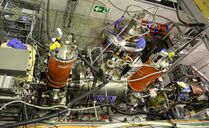BASE experiment
Topic: Physics
 From HandWiki - Reading time: 4 min
From HandWiki - Reading time: 4 min
BASE (Baryon Antibaryon Symmetry Experiment), AD-8, is a multinational collaboration at the Antiproton Decelerator facility at CERN, Geneva. The goal of the Japanese and German BASE collaboration[1] are high-precision investigations of the fundamental properties of the antiproton, namely the charge-to-mass ratio and the magnetic moment.
Experimental setup
The single antiprotons are stored in an advanced Penning trap system, which has a multi-trap system at its core. It consists of a reservoir trap,[2] a precision trap, an analysis trap and a cooling trap. The reservoir trap has the capability to store antiprotons for several years[3] and allows BASE to operate experiments independent from accelerator cycles. The precision trap is for high precision frequency measurements, and the analysis trap has a strong magnetic field inhomogeneity superimposed, which is used for single particle spin flip spectroscopy. By measuring the spin flip rate as a function of the frequency of an externally applied magnetic-drive, a resonance curve is obtained. Together with a measurement of the cyclotron frequency, the magnetic moment is extracted.
BASE physics
The BASE collaboration developed techniques to observe the first spin flips of a single trapped proton[4] and applied the double-trap technique to measure the magnetic moment of the proton with a fractional precision of three parts in a billion,[5] later improved to a precision of 300 parts in a trillion, [6] being the most precise measurement of this fundamental property of the proton. With the invention of a two particle/three trap technique BASE measured the antiproton magnetic moment with a fractional accuracy of 1.5 parts in a billion, which improved the previous most precise proton/antiproton comparison in that sector [7] by more than a factor of 3000. This measurement constitutes one of the most stringent tests of CPT invariance with baryons to date, and sets the most stringent limits on antimatter/dark matter interaction to date.[8]
Inspired by this work BASE has also used Penning trap detectors as axion haloscopes, and derived stringent narrow-band laboratory limits on the conversion of axions to photons.[9]
In 2022 BASE measured that the charge-to-mass ratios of protons and antiprotons are equal within a precision of 16 parts per trillion.[10][11] This measurement constitutes the most precise test of CPT invariance in the baryon sector and sets the first differential constraints on the clock weak equivalence principle using baryonic antimatter.
BASE collaboration
The BASE collaboration comprises the following institutions:
See also
References
- ↑ "official BASE website". http://base.web.cern.ch.
- ↑ Smorra, C.; Mooser, A.; Franke, K.; Nagahama, H.; Schneider, G.; Higuchi, T.; Gorp, S. V.; Blaum, K. et al. (2015-10-15). "A reservoir trap for antiprotons" (in en). International Journal of Mass Spectrometry 389: 10–13. doi:10.1016/j.ijms.2015.08.007. ISSN 1387-3806. https://www.sciencedirect.com/science/article/pii/S1387380615002560.
- ↑ Sellner, S; Besirli, M; Bohman, M; Borchert, M J; Harrington, J; Higuchi, T; Mooser, A; Nagahama, H et al. (2017-08-31). "Improved limit on the directly measured antiproton lifetime" (in en). New Journal of Physics 19 (8): 083023. doi:10.1088/1367-2630/aa7e73. ISSN 1367-2630. https://iopscience.iop.org/article/10.1088/1367-2630/aa7e73.
- ↑ Ulmer, S. (20 June 2011). "Observation of Spin Flips with a Single Trapped Proton". Physical Review Letters 106 (25): 253001. doi:10.1103/PhysRevLett.106.253001. PMID 21770638. Bibcode: 2011PhRvL.106y3001U.
- ↑ Mooser, A. (2014). "Direct high-precision measurement of the magnetic moment of the proton". Nature 509 (7502): 596–599. doi:10.1038/nature13388. PMID 24870545. Bibcode: 2014Natur.509..596M.
- ↑ Schneider, Georg; Mooser, Andreas; Bohman, Matthew; Schön, Natalie; Harrington, James; Higuchi, Takashi; Nagahama, Hiroki; Sellner, Stefan et al. (2017-11-24). "Double-trap measurement of the proton magnetic moment at 0.3 parts per billion precision" (in en). Science 358 (6366): 1081–1084. doi:10.1126/science.aan0207. ISSN 0036-8075. PMID 29170238. https://www.sciencemag.org/lookup/doi/10.1126/science.aan0207.
- ↑ ATRAP Collaboration; DiSciacca, J.; Marshall, M.; Marable, K.; Gabrielse, G.; Ettenauer, S.; Tardiff, E.; Kalra, R. et al. (2013-03-25). "One-Particle Measurement of the Antiproton Magnetic Moment". Physical Review Letters 110 (13): 130801. doi:10.1103/PhysRevLett.110.130801. PMID 23581304. https://link.aps.org/doi/10.1103/PhysRevLett.110.130801.
- ↑ ATRAP Collaboration; DiSciacca, J.; Marshall, M.; Marable, K.; Gabrielse, G.; Ettenauer, S.; Tardiff, E.; Kalra, R. et al. (2013-03-25). "One-Particle Measurement of the Antiproton Magnetic Moment". Physical Review Letters 110 (13): 130801. doi:10.1103/PhysRevLett.110.130801. PMID 23581304. https://link.aps.org/doi/10.1103/PhysRevLett.110.130801.
- ↑ Devlin, Jack A.; Borchert, Matthias J.; Erlewein, Stefan; Fleck, Markus; Harrington, James A.; Latacz, Barbara; Warncke, Jan; Wursten, Elise et al. (2021-01-25). "Constraints on the Coupling between Axionlike Dark Matter and Photons Using an Antiproton Superconducting Tuned Detection Circuit in a Cryogenic Penning Trap". Physical Review Letters 126 (4): 041301. doi:10.1103/PhysRevLett.126.041301. PMID 33576660. https://link.aps.org/doi/10.1103/PhysRevLett.126.041301.
- ↑ Borchert, M. J.; Devlin, J. A.; Erlewein, S. R.; Fleck, M.; Harrington, J. A.; Higuchi, T.; Latacz, B. M.; Voelksen, F. et al. (2022-01-06). "A 16-parts-per-trillion measurement of the antiproton-to-proton charge–mass ratio" (in en). Nature 601 (7891): 53–57. doi:10.1038/s41586-021-04203-w. ISSN 0028-0836. PMID 34987217. https://www.nature.com/articles/s41586-021-04203-w.
- ↑ "BASE breaks new ground in matter–antimatter comparisons" (in en). http://home.cern/news/news/physics/base-breaks-new-ground-matter-antimatter-comparisons.
External links
Record for BASE Experiment on INSPIRE-HEP
 |
 KSF
KSF


